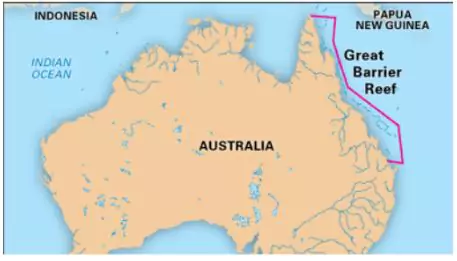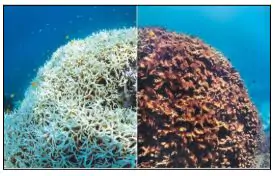According to a recent survey by the Australian Institute of Marine Science (AIMS), Australia’s Great Barrier Reef (GBR) has recorded its worst annual coral decline in nearly four decades, mainly due to severe mass bleaching in 2024.
Key Highlights of the Australian Institute of Marine Science (AIMS) Survey
- Survey Findings (August 2024 – May 2025): AIMS surveyed 124 reefs across the northern, central, and southern GBR.
- Of these reefs, 48% showed a decline in hard coral cover, 42% showed no net change, and only 10% showed an increase.
- This represents the lowest average coral cover recorded in nearly four decades of monitoring.
- Widespread Coral Loss: The 2024 bleaching event caused the largest spatial footprint of coral bleaching ever recorded on the reef.
- In some locations, hard coral cover fell by more than 70%, marking the sharpest decline since long-term monitoring began in 1986.
- Regional Trends: In the northern GBR, average coral cover dropped from 39.8% to 30%, a 24.8% decline, particularly around Lizard Island, which experienced the worst heat stress on record.
- In the central GBR, coral cover declined by 13.9%, down to 28.6%, with some stable or slightly increasing zones.
- The southern GBR experienced the sharpest relative decline, with coral cover falling from 38.9% to 26.9%, a 30.6% loss — the worst annual drop on record for the region.
About Lizard Island
- Lizard Island, situated in the Coral Sea off Queensland’s coast, is part of the Great Barrier Reef Marine Park. It is a UNESCO World Heritage site.
- Geological History: Lizard Island is a continental island that was once located about 20 km (12 mi) inland but became separated following post-Pleistocene flooding around 7,000 years ago.
- It was primarily formed by an orogenic pluton of porphyritic biotite and muscovite during the Permian age, around 300 million years ago.
|
- Compounding Factors: In addition to heat stress, cyclone damage, flood plumes, freshwater inundation, and outbreaks of crown-of-thorns starfish significantly worsened coral mortality.
- Coral disease was also widespread, particularly affecting corals that had survived bleaching.
- The Acropora genus, which includes fast-growing but heat-sensitive corals that had aided past reef recovery, was among the worst affected in 2024.
- Scientific Observations and Warnings: The coral cover on the reef is becoming more unstable, rising and falling sharply in short periods, unlike the more steady patterns seen in the past.
- Frequent bleaching events are giving the reef less time to recover, and climate change-driven heatwaves are now the biggest threat to its survival.
- AIMS also reported that this is the second time in a decade the reef has faced mass bleaching in back-to-back years, something that was rare before the 1990s.
- Global Coral Crisis: Between January 2023 and May 2025, the United States National Oceanic and Atmospheric Administration (NOAA) reported that 83.9% of the world’s coral reefs were exposed to bleaching-level heat stress.
- Mass bleaching was reported in at least 83 countries and territories, showing the global scale of the crisis.
About Great Barrier Reef

- The Great Barrier Reef (GBR) is the largest coral reef system globally.
- Situated In: In the Coral Sea off Queensland, Australia. Stretching over 2,300 km, it comprises approximately 3,000 individual reefs and 900 islands.
- World Heritage: The GBR is also a habitat for endangered species like the dugong and the large green turtle. Designated as a UNESCO World Heritage site, it was added to the list in 1981.
- Marine Protected Area: A significant portion of the Great Barrier Reef is designated as a marine protected area, overseen by Australia’s Great Barrier Reef Marine Park Authority.
About Corals
- Coral Polyps: Corals consist of genetically identical polyps that form large reef structures.
- Zooxanthellae Algae: These unicellular algae live within coral tissues, providing nutrients through photosynthesis.
- Types of Corals:
- Hard Corals (Stony Corals): Build reefs by extracting calcium carbonate from seawater.
- Soft Corals: Do not form reefs but attach to existing coral structures.
- Ecological Importance:
- Support 25% of marine biodiversity, including fish, crustaceans, and mollusks.
- Act as natural coastal barriers, protecting shorelines from erosion and storm surges.
- Contribute to fishing and tourism industries, benefiting global economies.
About Coral Bleaching

- When corals are stressed by changes in conditions such as temperature, light, or nutrients, they expel the symbiotic algae (zooxanthellae) living in their tissues, causing them to turn completely white.
- This is called coral bleaching.
- Reversibility: If temperatures stabilize quickly, corals can recover by regaining zooxanthellae.
Reasons for Coral Bleaching
| Climate-Related Factors |
- Rising Sea Temperatures: Global warming has caused SSTs to rise by 1°C in the last century.
- Marine Heatwaves: Rapid temperature increases trigger bleaching (e.g., 2020 event in the Gulf of Mannar, India).
- El Niño Events: Cause localized warming, worsening bleaching conditions.
|
| Other Contributing Factors |
- Sedimentation: Coastal development and bottom trawling deposit sediments that block sunlight, hindering coral photosynthesis.
- Ocean Acidification: As carbon dioxide levels rise, oceans take in more of it, leading to increased acidity in the water.
- This heightened acidity hampers corals’ ability to form the calcareous skeletons they rely on for survival
- Biological Invasions: Invasive species like crown-of-thorns starfish and algae outcompete bleached corals.
- Chemical Pollution: Exposure to oil, herbicides, and heavy metals can kill zooxanthellae.
- Pathogen Attacks: Some coral diseases strip coral tissues, leaving behind a bare skeleton.
|
Impact of Coral Bleaching
- Loss of Marine Biodiversity: Coral-dependent species face habitat destruction.
- Decline in Fisheries: Affected reefs reduce fish stocks, harming livelihoods.
- Increased Coastal Erosion: Dead reefs can no longer protect shorelines.
- Economic Losses: Coral tourism and fisheries face major revenue declines.
Global Efforts to Conserve Coral Reefs
- International Coral Reef Initiative (ICRI): A global partnership to protect reefs, with India as a member.
- World Coral Conservatory Project: Establishing coral banks in European aquariums to aid reef restoration.
- Biorock Technology: Uses electric currents to stimulate coral growth (e.g., Gulf of Kachchh, India).
- Super Corals: Breeding heat-resistant coral strains to withstand rising temperatures.
Indian Government Initiatives for Coral Conservation
- Coral Transplantation Projects:
-
- Gulf of Mannar Biosphere Reserve: Uses artificial reef structures to restore damaged reefs.
- Lakshadweep and Andaman & Nicobar Islands: Coral gardening projects underway.
- National Coastal Mission: Aims to protect marine ecosystems, including coral reefs.
- Regulations on Coastal Development: Stricter policies to prevent habitat destruction.
- Marine Protected Areas (MPAs): Several MPAs safeguard coral ecosystems from overfishing and pollution.
| PWOnlyIAS Extra Edge:
The Fourth Global Mass Coral Bleaching Event (2023–Ongoing)
- A catastrophic global coral bleaching event began in early 2023, confirmed by the National Oceanic and Atmospheric Administration (NOAA) and the International Coral Reef Initiative (ICRI).
- It is the most widespread bleaching event ever recorded, affecting coral reefs across the Atlantic, Pacific, and Indian Oceans
- What is Happening?
- Widespread Impact: By mid-2025, around 84% of the world’s coral reef areas had experienced bleaching-level heat stress, exceeding the 68% impact recorded during the third global bleaching event (2014–2017).
- Faster and More Intense: The bleaching is spreading more quickly and is more severe than past events. In the Atlantic Ocean, almost every coral reef has been affected.
- Bleaching is Not Always Death: Coral turns white (bleaches) when stressed by heat due to the loss of algae living inside them. If water cools down in time, corals can recover, but long heat exposure leads to death.
- Key Causes:
- Record Ocean Temperatures: The main driver is unusually high sea surface temperatures, caused by human-driven climate change. Oceans absorb over 90% of excess heat from global warming.
- El Niño Phenomenon: The El Niño climate pattern, which brings warmer waters in the Pacific Ocean, has worsened the warming, making bleaching more widespread and intense.
- Consequences and Outlook:
- High Coral Mortality: In many places, coral has died in large numbers. For example, in the Great Barrier Reef, the 2024 bleaching event caused the biggest yearly coral cover loss in nearly 40 years.
- Ecosystem Breakdown: Coral reefs, called the “rainforests of the sea,” support millions of marine species. Their decline threatens biodiversity and marine food chains.
- Economic Damage: Coral reef loss affects local economies dependent on fishing and tourism.
- Grim Future Without Action: Scientists warn that without urgent action to reduce greenhouse gas emissions and stabilize ocean temperatures, mass bleaching could happen every year in most coral reefs by 2050.
|
![]() 7 Aug 2025
7 Aug 2025



